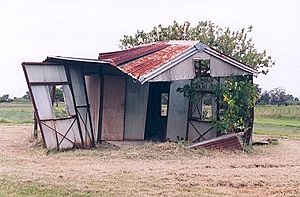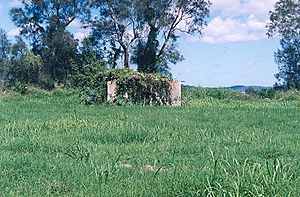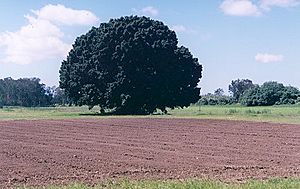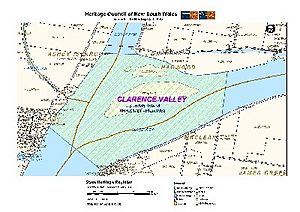Ulgundahi Island facts for kids
Quick facts for kids Ulgundahi Island |
|
|---|---|
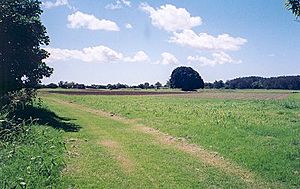
Farmland on Ulgundahi Island
|
|
| Location | Clarence River by North Arm, Maclean, Clarence Valley Council, New South Wales, Australia |
| Built | 1904–2003 |
| Owner | Yaegl Local Aboriginal Land Council |
| Official name: Ulgundahi Island | |
| Type | state heritage (landscape) |
| Designated | 24 December 2004 |
| Reference no. | 1721 |
| Type | Historic site |
| Category | Aboriginal |
| Lua error in Module:Location_map at line 420: attempt to index field 'wikibase' (a nil value). | |
Ulgundahi Island is a special place for Aboriginal people. It is located on the Clarence River in New South Wales, Australia. For many years, it was a settlement where Aboriginal families lived. Today, it is still used for farming and holds deep meaning for the local Yaegl people.
The Yaegl Local Aboriginal Land Council owns the island. It was added to the New South Wales State Heritage Register on 24 December 2004. This means it is a very important historical site that needs to be protected.
Contents
A Brief History of Ulgundahi Island
Ulgundahi Island has been a home for Aboriginal people since at least 1880. At that time, many Aboriginal people moved to the island. This happened because European settlers brought new diseases. Also, their farms took over much of the land.
Becoming an Aboriginal Reserve
In 1904, a part of Ulgundahi Island was officially made an Aboriginal reserve. It was managed by a group called the Aboriginal Protection Board (APB). By 1907, the entire island became part of this reserve. The name Ulgundahi comes from a Yaegl word. It means "shape of an ear."
Some families already lived on the island. In 1904, the APB decided to set aside eight acres for a reserve. They also sent supplies like roofing iron and water tanks. European residents had concerns about Aboriginal camps near towns. So, in 1908, the APB moved families from Ashby to Ulgundahi Island. This made the island's population grow to 60 people. In 1909, Aboriginal people from Harwood Island also came to Ulgundahi. They had to leave their homes because a European farmer burned down their camp.
Life on the Island: Farming and Rations
Life on the island was based on farming. Each family head had about three to four acres of land. They grew crops like maize, cane, and vegetables. The idea was to help them work and sell any extra food they grew.
Children received a small payment of 5 shillings a week. Families in need also got food supplies. For example, adults who couldn't earn enough received weekly rations. These included flour, sugar, jam, potatoes, and onions. Children received half of an adult's ration.
The APB also gave out clothes. These clothes were all the same: black trousers and blue shirts for boys. Girls received purple dresses. No one had shoes. The island manager also gave out medicine. This included things like quinine, cod liver oil, and kerosene.
Education and Community Life
In 1908, the APB hired a European manager for Ulgundahi Island. This manager also worked as the school teacher. He lived in Ashby and traveled to the island by boat each day. The Aboriginal Provisional School was set up on the island that same year. It had a building, outhouses, and a water tank.
Some children from the island went to Maclean School. However, parents of European children sometimes objected to Aboriginal children attending the same school. The children on the island were taught very little. They were mainly trained for jobs in the white community. Boys became farm laborers, and girls worked in domestic service.
In 1910, the island residents built a small church. A report from 1921 says that Mr. John Cameron helped pay for and furnish the church. Before 1910, a minister named Rev. Scott Neil visited the island often. His sister taught Sunday School classes. Other church groups, like the Baptists and Salvation Army, also helped. An organ was later added to the church.
Families were not forced to stay on the island. But it was hard to leave because European society was often unfriendly. Also, the manager could give an absent family's home to someone else. These reasons often made people stay.
Farming and Floods
Men on the island harvested sugar cane. They took it to the Harwood mill. Each home had its own fruit trees. These included peaches, oranges, mangoes, and grapes. People with vegetable gardens would pick and prepare their produce for markets. However, any money earned from selling cane or vegetables went to the APB. The people who grew and sold the food did not keep the money. By 1911, the APB reported that almost everyone on the island was self-sufficient.
The island often flooded, which caused problems. The 1921 flood was particularly bad. Families were sometimes left to take care of themselves for up to three months. More floods happened in 1928 and during the 1940s and 1950s. In 1951, the government school on the island closed. Children then had to travel by boat to Maclean for school. In 1958, the APB manager retired and was not replaced.
Moving Off the Island
Yaegl families often left the island for holidays or camps. These trips lasted from one to two weeks, or even a whole summer. A popular spot was Murrayville, a part of the Clarence River. Families would camp there for six weeks. They enjoyed finding "wild food" like "cobra" or wood worms. Ashby was another camp used, especially when the island flooded. Yamba was also a favorite place. Families visited for the summer to find food from the coast and waters.
By 1961, most Aboriginal families had moved from Ulgundahi Island. They went to Aboriginal reserves in Yamba and Maclean. The APB stopped managing the island towards the end of the 1950s. In 1956, the Hillcrest Aboriginal Reserve was created near Maclean. Several houses were built there for families who wanted to move. By 1962, the last Aboriginal families had left Ulgundahi Island for Hillcrest.
What Ulgundahi Island Looks Like Today
Ulgundahi Island is located in the Clarence River. It is about 14.16 hectares in size and about 1.5 kilometers long. The western end of the island is always changing shape. This is because silt builds up there. Cardy Craig and his first wife, Sarah Blakey, were the first Aboriginal Australians to own land here in 1909. The Craig family later moved south.
When the APB managed the island, Aboriginal people grew crops. They farmed cane, corn, and vegetables. Today, parts of the island are still used by the local Aboriginal community for farming.
There are two old buildings left on the island, but they are in poor condition. One is on the northwest side, and the other is towards the southeast. The main building on the northwest side is thought to be the first house built on the Mission. It is made of corrugated iron. It still has its original timber floor. The other building is also made of corrugated iron. It does not have a roof, but its walls are still standing. It is covered in vines.
A new covered area now stands on Ulgundahi Island. This allows school groups and community members to visit and sit there.
A very important symbol remains on the island: a large fig tree. It is located towards the western end of the island. Fig trees are very special to the Yaegl community. They believe that fig trees hold spirits and should not be disturbed.
The island continues to change because of ongoing farming. The community also plans to add signs and information for visitors. They also want to fix up the old houses.
Why Ulgundahi Island is Important
Ulgundahi Island and the waters around it are very important. They hold great cultural, social, spiritual, and historical value for the Yaegl people. They are also important to other Aboriginal people connected to the island.
In 1904, Ulgundahi Island became an Aboriginal Reserve. It became home to many local Aboriginal people. These people had been living in camps around Maclean and the Lower Clarence Region. This included places like Southgate, Ashby, Lawrence, and Ulmarra.
Ulgundahi Island was one of many Mission sites in New South Wales. Its social importance comes from its connection to the Aboriginal Protection Board. This board moved Aboriginal people from towns and cities. They tried to remove all signs of Aboriginal culture.
Today, the island is still very important to the Yaegl people. It also matters to other Aboriginal people who have a link to the island. The Yaegl community still uses the island for things like educational tours and organic farming.
Ulgundahi Island was listed on the New South Wales State Heritage Register on 24 December 2004. This means it meets certain important standards.
Historical Significance
Ulgundahi Island shows how cultural history unfolded in New South Wales. It became an Aboriginal Reserve in 1904. Aboriginal families were moved there from all over the Lower Clarence region. By 1905, 21 people lived on the island. The site shows how these groups lived there. The Yaegl people of Maclean still have a strong connection to the land.
Cultural and Spiritual Significance
Ulgundahi Island has a strong and special meaning for the Yaegl people. It is important for their social, cultural, historical, and spiritual values. The area is known for its dreaming stories. These stories tell how the Clarence River was made by a powerful old woman named Dirrangun.
The island became a central place for all the communities nearby. People were born, married, and died there. Today's Aboriginal community remembers every one of them. For Aboriginal people today, the island is a symbol. It shows how their place in history has changed. It also shows their strength to survive challenges. It reminds them of their culture and their connection to the land.
Demonstrating a Way of Life
Ulgundahi Island and its surrounding waters are very important to the Yaegl people. They show their cultural heritage values. The area is special because it shows a particular way of life for the Yaegl people. It also shows how other Aboriginal people lived on the island.
There are no complete buildings left, only the frames of the first house and a smaller structure. But the connection to the land and its spiritual and cultural values remain strong.


